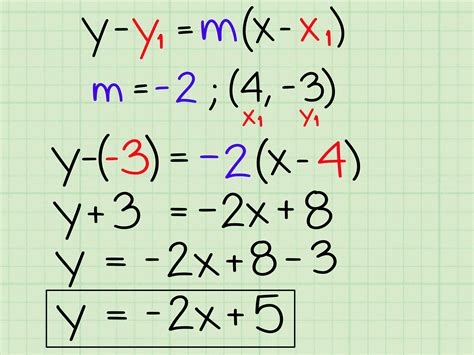Converting equations to slope-intercept form is a fundamental skill in algebra and mathematics. Slope-intercept form, denoted as y = mx + b, is a convenient way to express linear equations, where m represents the slope and b represents the y-intercept. In this article, we will explore the importance of converting equations to slope-intercept form and provide a step-by-step guide on how to do it.
Converting equations to slope-intercept form is essential in various mathematical applications, such as graphing linear equations, finding the equation of a line, and solving systems of linear equations. It provides a clear and concise way to represent linear relationships between variables. Moreover, slope-intercept form makes it easier to identify the slope and y-intercept of a line, which are crucial in understanding the behavior of the line.
In this article, we will discuss the benefits of converting equations to slope-intercept form, provide a detailed explanation of the process, and offer practical examples to illustrate the concept.
Understanding Slope-Intercept Form

Before we dive into the steps to convert equations to slope-intercept form, let's review the concept of slope-intercept form. Slope-intercept form is a way to express a linear equation in the form y = mx + b, where:
- m represents the slope of the line
- b represents the y-intercept of the line
The slope (m) represents the rate of change of the line, while the y-intercept (b) represents the point where the line crosses the y-axis.
Step 1: Identify the Equation
The first step to convert an equation to slope-intercept form is to identify the given equation. The equation can be in any form, such as standard form (ax + by = c), point-slope form (y - y1 = m(x - x1)), or another form.
For example, let's consider the equation 2x + 3y = 7. This equation is in standard form.
Standard Form to Slope-Intercept Form
To convert the equation 2x + 3y = 7 to slope-intercept form, we need to isolate y.
2x + 3y = 7
Subtract 2x from both sides:
3y = -2x + 7
Divide both sides by 3:
y = (-2/3)x + 7/3
Now the equation is in slope-intercept form, where m = -2/3 and b = 7/3.
Step 2: Rearrange the Equation

The second step is to rearrange the equation to isolate the y-variable. This step involves adding, subtracting, multiplying, or dividing both sides of the equation by the same value to get y alone.
For example, consider the equation x - 2y = 4. To convert this equation to slope-intercept form, we need to isolate y.
x - 2y = 4
Subtract x from both sides:
-2y = -x + 4
Divide both sides by -2:
y = (1/2)x - 2
Now the equation is in slope-intercept form, where m = 1/2 and b = -2.
Step 3: Simplify the Equation
Simplify Fractions and Decimals
The third step is to simplify the equation by combining like terms, simplifying fractions, and eliminating decimals.
For example, consider the equation y = (3/4)x + 2.5. To simplify this equation, we can convert the decimal to a fraction.
y = (3/4)x + 5/2
Now the equation is in slope-intercept form with simplified fractions.
Step 4: Identify the Slope and Y-Intercept

The fourth step is to identify the slope (m) and y-intercept (b) from the equation in slope-intercept form.
For example, consider the equation y = 2x - 3. The slope (m) is 2, and the y-intercept (b) is -3.
Step 5: Verify the Equation
Plug in Values to Verify
The final step is to verify the equation by plugging in values to ensure that it satisfies the original equation.
For example, consider the equation y = 2x - 3. Let's plug in x = 2 and y = 1 to verify the equation.
1 = 2(2) - 3
1 = 4 - 3
1 = 1
The equation is true, and we have verified that the equation y = 2x - 3 is in slope-intercept form.
In conclusion, converting equations to slope-intercept form is an essential skill in algebra and mathematics. By following the 5 steps outlined in this article, you can convert equations to slope-intercept form and gain a deeper understanding of linear relationships.
We hope this article has been helpful in your journey to master slope-intercept form. Share your thoughts and questions in the comments below, and don't forget to share this article with your friends and classmates.
What is slope-intercept form?
+Slope-intercept form is a way to express a linear equation in the form y = mx + b, where m represents the slope and b represents the y-intercept.
Why is it important to convert equations to slope-intercept form?
+Converting equations to slope-intercept form is essential in various mathematical applications, such as graphing linear equations, finding the equation of a line, and solving systems of linear equations.
How do I identify the slope and y-intercept from an equation in slope-intercept form?
+The slope (m) is the coefficient of x, and the y-intercept (b) is the constant term in the equation.
